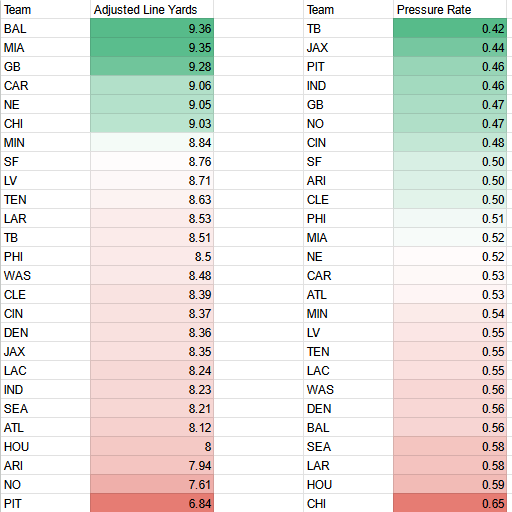Projecting line play — or the line’s impact on fantasy scoring — is one of the more challenging tasks in all of DFS.
While quantitative measures exist, they can be lacking to an extent. On the player level, grading services like Pro Football Focus are notoriously challenged with offensive line play. It’s difficult to know which member of a line blew an assignment, for example.
Things are a bit easier on the team level, as assessing the unit’s overall success is more practical.
However, we’ll still be taking a glance at qualitative sources. Including Action Network’s Brandon Anderson ranking all 32 NFL offensive lines. On the defensive side, PFF’s defensive line rankings will be the main source.
We also have projected sacks in our NFL Player Models.
The Data
Below is a table featuring every offense’s combined adjusted line yards and pressure rate combined with the opposing defensive units. Adjusted line yards are a Football Outsiders (now at FTN) statistic that quantifies how much of a team’s rushing yards gained/allowed are attributable to the offensive or defensive lines. Adjusted sack rate measures sacks against down-and-distance rates to quantify how many more or fewer sacks on average a team is recording/allowing.
With adjusted line yards, higher numbers are better for the offensive unit. With pressure rate, lower numbers are better. Both factors should be considered, though. For example, a running back will score more fantasy points on average when his team’s passing attack is functioning well, and vice versa for quarterbacks.
Starting in Week 5, these numbers became matchup-adjusted, which should make them far more efficient. Each week, they become slightly more predictive. However, they don’t take injuries into account, so keeping up with those are important.
This year, I’m switching from sack rate to pressure rate to try to eliminate quarterback play from the analysis. However, high pressure rate can be a good thing for rushing quarterbacks — they’re more likely to scramble when under duress, which is great for DFS production.

All Data From 2022 NFL Season
Strong Offensive Line Matchups
Green Bay Packers OL (#3 in Combined Line Yards, #5 in Combined Pressure Rate) vs. Chicago Bears DL
The chart above is handy for visualization purposes, but it’s entirely based on last year’s data. Fortunately, Anderosn’s rankings have the Packers similar to last year’s squad, which produced the second-best adjusted line yards and a top-five pressure rate in the league.
While pressure rate is a more accurate reflection of offensive line play than adjusted sack rate, it still depends somewhat on the quarterback. It’s likely the downgrade from Aaron Rodgers to Jordan Love ($5,000) could cause an increase in pressure, even with similar offensive line play.
But probably not this week, as the Bears rank 31st in PFF’s defensive line rankings. That’s (remarkably) a slight improvement from last year, but certainly not a unit to shy away from.
Young quarterbacks generally do better with more time in the pocket, so it could be a good week to roster Love at his near-minimum salary on DraftKings. Stacking with Christian Watson ($6,000) is particularly appealing since the deep-threat nature of Watson’s routes requires solid pass protection.
Of course, the obvious beneficiaries of the mismatch are the running backs, with both Aaron Jones ($6,300) and AJ Dillon ($5,200) worth considering for Week 1. Jones, in particular, is projected as one of the top RB plays on the slate.
Be sure to check out all the pick’ems Sleeper has to offer with Sleeper Fantasy promo code LABS1 for a $100 deposit match.
Baltimore Ravens OL (#1 in Combined Line Yards, #22 in Combined Pressure Rate) vs. Houston Texans DL
The possible issues in pressure rate make the Ravens seem like a curious choice. There are a couple of reasons to include them, though. First, Anderson has them as one of the biggest movers in his line rankings since last year. This year, they’re ranked sixth after starting 2022 ranked 14th.
With Houston ranking 23rd in PFF’s list, there’s obviously a mismatch. Houston drafted the class’s top pass rusher in Will Anderson, but that doesn’t do much for their run defense — and he’ll probably not be a huge factor this early in the season.
Even if he is, pressure on Lamar Jackson ($8,000) isn’t a bad thing. Forcing him out of the pocket is great for his fantasy production, so it’s a win-win for him. I’m targeting the Ravens run game in general, but that includes Jackson.
Cleveland Browns OL (#3 in Anderson’s Offensive Line Rankings) vs. Cincinnati Bengals DL
The Bengals are an above-average defensive line by all accounts, checking in at 11 on the PFF list. They’re not elite though, unlike the offensive unit in front of them.
Cleveland is Anderson’s second-best offensive line unit, and he took particular care to note that they’re a better run-blocking unit than pass-blocking. This is perfect since they’re blocking for a mobile quarterback and perhaps the league’s best pure rusher in Nick Chubb ($8,200).
It might not be an ideal time to play Chubb with the Browns as slight underdogs, but he’s fairly matchup-independent in terms of his workload. He should get enough touches to have a strong shot at the 100-yard rushing bonus on DraftKings, with touchdowns deciding whether he has a solid day or a huge one.
Deshaun Watson ($6,000) is interesting, too, especially if he can return to his early-career rushing production. That’s hard to bank on with how badly he played last season, though. I’ll be taking a wait-and-see approach on Watson in all but the largest of tournaments.
Strong Defensive Line Matchups
Green Bay Packers DL (#1 in Combined Pressure Rate) vs. Chicago Bears OL
I’m expecting Green Bay ($2,800) to dominate the trenches on both sides of the ball this week. Chicago was the worst offensive line in the league last season, and while Anderson is projecting some improvements, they’re still ranked just 25th.
While PFF has the Packers defensive line slightly below average, they used a top-15 pick on edge rusher Lukas Van Ness and should be better rushing the passer than they are stopping the run.
Coupled with Justin Fields’ ($7,700) propensity to take sacks and give the ball away, and Green Bay has a much higher ceiling than their salary would suggest.
Seattle Seahawks (#3 in Combined Pressure Rate) vs. Los Angeles Rams OL
The Rams’ once-great offensive line has fallen apart in recent seasons, with a combination of injuries and retirements giving them no real continuity from their Super Bowl days. That was born out in last year’s statistics, and there’s not really much reason to expect them to be any better this season.
Seattle’s ($3,300) defensive line is fairly poor as well, but they should still have the upper hand against this terrible offensive unit. They’re facing a slow-footed quarterback in Matthew Stafford ($5,700), who will be missing his security blanket in Cooper Kupp in Week 1.
Without Kupp’s quick-hitting routes, Stafford will have to hold on to the ball longer — a scary proposition given the line in front of him. Stafford also trails only Brett Favre in career pick-sixes thrown, and with 3,000 fewer attempts than Favre, there’s a good chance he owns that record to himself someday.






